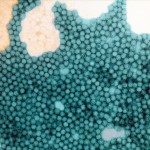Link to Pubmed [PMID] – 12185273
J. Gen. Virol. 2002 Sep;83(Pt 9):2193-200
Natural recombination in poliovirus is a frequent phenomenon. In practice, whenever different genotypes have the opportunity to infect the same individual, a high proportion of viruses with recombinant genomes are excreted. To determine whether enteroviruses other than poliovirus can naturally produce viable virions with recombinant genomes, we studied the molecular features of two distant regions of the viral genomes – the VP1 coding region and the 3D polymerase coding region – of the echovirus serotypes associated with a large outbreak of aseptic meningitis. Nucleotide sequences of nine epidemic strains [belonging to echovirus serotypes 4 (E4), 7 (E7) and 30 (E30)] in the two genomic regions (300 nt of VP1 and 520 nt of 3D polymerase) were compared to prototype and field strains, and phylogenetic trees were generated from alignments. In the VP1 region, each of the three epidemic serotypes clustered with the homotypic prototype strain, whereas in the 3D polymerase region, E7 and E30 grouped as a single cluster, distant from the two corresponding prototype strains. This suggests that one of these two E7 and E30 strains has evolved through recombination with the other or that both have acquired the 3D polymerase coding region from a common ancestor. Our results suggest that such genetic recombinations between different echovirus serotypes are possible when multiple epidemic strains are circulating simultaneously.


